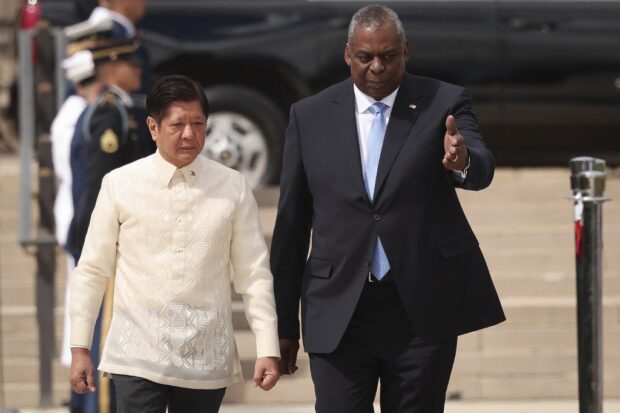‘We’re family’: PH, US boost intel sharing

Philippines President Ferdinand Romualdez Marcos Jr. (L), is escorted by U.S. Secretary of Defense Lloyd Austin (R) during an arrival ceremony at the Pentagon May 3, 2023 in Arlington, Virginia. AFP
The Philippines and the United States took a step closer toward a broader intelligence-sharing pact to deepen their defense alliance in the face of China’s aggression in the South China Sea.
Both sides have agreed to bolster intelligence security by consulting with each other on policies, practices and procedures related to the protection of defense and military classified information and in pursuit of a General Security of Military Information Agreement (GSOMIA), according to new bilateral defense guidelines released on Wednesday.
The treaty allies announced the adoption of the US-Philippines Bilateral Defense Guidelines after President Marcos visited the Pentagon as part of his five-day working visit to the US capital.
US Defense Secretary Lloyd Austin III, who welcomed the Philippine leader, assured Marcos of Washington’s readiness to come to Manila’s defense should any of its assets in the South China Sea come under attack, as mandated under the Mutual Defense Treaty.
The guidelines were a first since the treaty was signed in 1951 and follow scores of Philippine diplomatic protests in the past year over China’s “aggressive” actions and threats against the Philippine Coast Guard (PCG).
‘Gray zone tactics’
The guidelines said the bilateral treaty commitments would be invoked if either was attacked in the South China Sea and also if coast guard vessels were targeted.
They included references to modern forms of warfare, including “gray zone tactics,” which China is accused of using to assert its claims to sovereignty. The guidelines did not specifically mention China.
“We’re more than allies. We’re family,” Austin told the President at the start of their meeting.
“So make no mistake, Mr. President. We will always have your back in the South China Sea or elsewhere in the region,” he said.
In April, the two allies agreed during a high-level meeting of top diplomats and defense officials to conclude the GSOMIA by the end of 2023.
Deliberate, wide-ranging
According to a fact sheet on the new defense guidelines, both parties will broaden information sharing on early indicators of threats confronting the alliance to be able to respond to challenges.
The United States has been providing intelligence to the Philippines during the latter’s resupply missions to Ayungin (Second Thomas) Shoal, Philippine security officials confirmed to the Inquirer.
At present, a handful of Filipino sailors and Marines are stationed on the rusty BRP Sierra Madre, a warship deliberately grounded near the shoal to serve as an outpost. But Chinese ships often make it difficult for Philippine vessels to bring supplies to the troops there, the officials said.
While the two allies are already sharing information, the GSOMIA will formalize the intelligence-sharing activities and form protocols, said a defense official who spoke on condition of anonymity.
“Our intel sharing efforts will be more deliberate. We can focus on pressing issues. We can formally establish intel sharing processes … We can perhaps avail [ourselves] of their assets or intel platforms and of various training and conferences/seminars. This is more wide-ranging compared to an informal arrangement,” the official said.
The agreement could also cover certain limitations of intelligence sharing with other countries and entities, he added.
Safeguarding documents
A Filipino diplomat, in a message to the Inquirer, described the GSOMIA as a “legal framework/agreement for the proper handling and safeguarding of classified documents or information.”
“Its conclusion allows stable and protected intel and info sharing,” the diplomat added.
The bilateral defense guidelines were approved two weeks after a PCG patrol vessel nearly collided with a China Coast Guard ship that blocked its path while conducting routine patrol operations at Ayungin.
‘Provocative, unsafe’
The April 23 incident prompted the US Department of State to call on China to refrain from “provocative and unsafe conduct” in the disputed waterway.
Marcos and Austin also talked about a plan to “swiftly operationalize” the four additional areas in the Philippines that American forces may access under the Enhanced Defense Cooperation Agreement (Edca).
“In addition to the five existing Edca locations, these new sites will enable combined training, exercises and other cooperative activities,” according to a Pentagon readout.
Responding to Austin’s remarks, the President said he looked forward to working with the United States in meeting “new challenges that perhaps we have not faced before.”